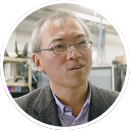Researchers at Meiji University are full of ideas for overcoming all sorts of challenges,
but solving real-world problems is no easy matter.
They keep on trying in the belief that someday they will make a difference.
Why? Because they know that possibilities are boundless.




An organ transplant may be the only option, but what if a donor can’t be found? Incurable genetic diseases may need research, but what if there are few cases to study? Professor Hiroshi Nagashima is at the forefront of research that could overcome such hurdles with groundbreaking animal cloning technology, with the aim of creating transplantable organs for use in humans. Learn more about this heroic, life-saving research.

Hiroshi Nagashima has been pursuing research related to the use of genetically engineered and cloned pigs, with the aim of regenerating organs to overcome severe and incurable diseases. His current research focuses on animal cloning, the creation of transgenic animals, and their applications in transplants and regenerative medicine.




Today’s world calls for decarbonization, yet we still rely on plastics. Associate Professor Takashi Osanai wants to resolve this problem with the help of algae, by using the mechanism of photosynthesis to make bioplastics from CO2. And his efforts go beyond research: to commercialize the technology, he has launched a bioventure from Meiji University, which he manages himself.

Specializes in biotechnology, metabolic engineering, and molecular biology. His research focuses on environmental biotechnologies for production of biomaterials and bioenergy using photosynthetic microalgae. To apply his findings in the real world, he is developing technologies that use light and carbon dioxide to protect the environment and resolve resource challenges.




The more robots look like humans, the creepier they seem. You may know this feeling, but what kind of robots could we accept? Professor Takanori Komatsu of Meiji University is exploring this question from a human psychology perspective. Deep down, maybe we just don’t want to get along with robots. What do you think?

Specializes in cognitive science and human-computer interaction. He conducts research to observe and analyze the relationship between people and artifacts, considering human cognitive attributes. Lately he has taken particular interest in examining why robots haven’t become part of our daily lives and reducing subjective lag times between users and IT devices.




Professor Yuki Morinaga, an expert in climatology and environmental science, became obsessed with fermented horse milk, known in Mongolia as “airag.” Her interest was triggered by the wisdom of nomads, who live in tune with nature. Professor Morinaga’s efforts to scientifically analyze and record the dwindling airag culture provide many tips on rich diversity of nutrition and microbes, environmentally friendly production methods, animal welfare, and more.

Specializes in climatology and environmental science. She attempts to verify and inherit the traditional knowledge of Mongolian nomads. She also disseminates Japan's pollution experience such as Minamata disease to developing countries. She participated in the 29th Japanese Antarctic Research Expedition as Japan's first female member.




About 9,000 years ago, lacquer has been used for eating utensils in Japan. Professor Takayuki Honda is a leading expert in the scientific study of lacquer. With its beautiful deep gloss and strong coating, lacquer merits fond use over a long period, and is an eco-material that ultimately returns to nature. While being an ancient material closely tied to Japanese culture, lacquer can also help to resolve environmental issues, for example by reducing CO2 emissions. Find out more about research on this challenge.

Specializes in analysis of organic compounds and development of methods. We are mainly conducting research on natural organic matter such as lacquer, glue, and pine resin. In particular, we have analyzed the heritage and excavated relics that are thought to have used these natural organic substances, and have clarified "what they were made of" chemically. On the other hand, we are also developing environment-friendly materials made from these natural organic substances.




Imagine something you want in the future and harness the power of computers and 3D printers to create a prototype. In Professor Homei Miyashita’s lab, students are exploring the future by giving form to these kinds of ideas. What can we make, and how, to live more happily? A whole range of challenges is under way.

His research area is Human-Computer Interaction. He explores how advanced technologies such as Virtual Reality, 3D printers, drones and taste displays can be integrated into our daily lives.




Professor Yoji Kuroda is working on practical application of user-friendly robots capable of performing security duties and dangerous work as a tool of humans. Robots hold the key to resolving Japan’s labor shortage, but in order to move around smoothly and do their work even in crowds, they need plenty of real-world experience. Enter the new robot recruit. It makes you want to keep a fond eye on it.

His research field is autonomous mobile robot, and he was a member of JAXA's Hayabusa project. While conducting academic research at the university, he aims to apply the resulting robotics technology to create a sustainable industry to help people.




Optical illusions have long depicted mysterious three-dimensional shapes. Now Professor Kokichi Sugihara is using the power of mathematics to create such shapes for real. Optical illusions occur when our brains unconsciously augment two-dimensional information reflected on our retinas by converting it into three dimensions. That’s why we can’t “unsee” such illusions even once we know how the trick is done. Perhaps we should simply enjoy the mystery.

His research area is mathematical engineering. In his study of mathematical modeling of the human vision system, he found new types of optical illusions such as impossible motion illusion and ambiguous cylinder illusions.




Origami can create various shapes from a single sheet of paper, and its techniques have even been used in space. The only obstacle to exerting its full potential is achieving mass production. Professor Ichiro Hagiwara is working to solve this problem with 3D origami printers and robots. He believes origami-based manufacturing will change our lives in the near future. Watch the video to discover more.

His research area is Origami engineering. In his study of industrialization of Origami structure by cheap forming method, he has developed Origami 3D printer with Origami robot which keeps foldable and deployable function of Origami structure.


Information noted in the videos, such as positions and affiliations, is current at the time of production.